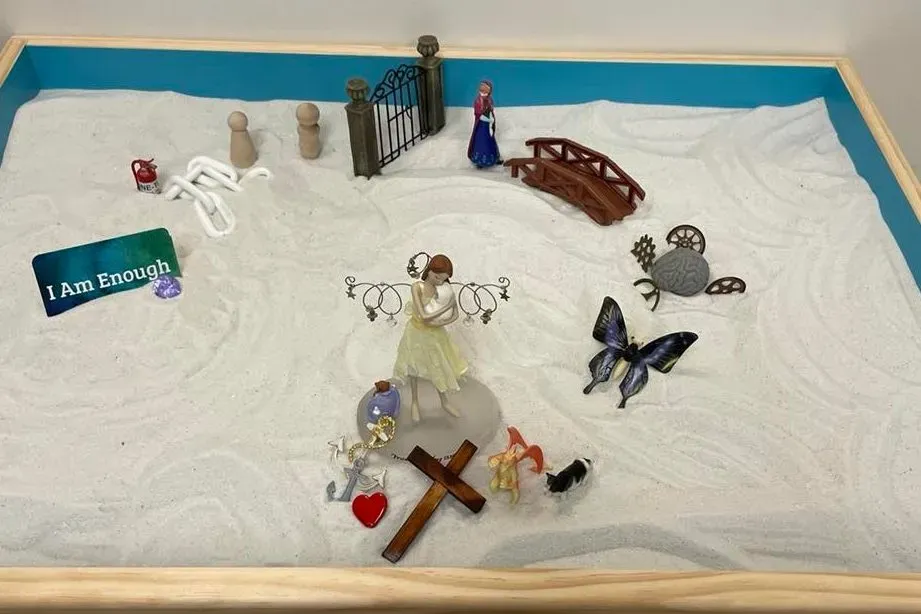Mental Health Therapy and Counseling for adults, teens, children, couples and families.
Blue Lavender Clinical Explains
Sandtray Therapy: Healing Through Symbolic Play
Sandtray therapy is an innovative therapeutic modality that provides a safe space for clients to explore their inner worlds through creative play. By using a variety of miniatures and natural elements in a sandbox, individuals can express emotions, work through psychological issues, and discover insights that may be difficult to uncover through traditional talk therapy. This approach is applicable for both children and adults dealing with trauma, anxiety, and various emotional challenges.
Dr. Linda Cunningham, a noted advocate for sandtray therapy, states, "Sandtray therapy empowers clients to create a tangible representation of their internal experiences. It is through this creative process that they can uncover and process difficult emotions in a supportive environment" (Cunningham, 2016). The act of arranging objects in sand helps individuals communicate complex feelings that may not easily find expression in verbal language.
The theoretical underpinnings of sandtray therapy draw inspiration from the work of Carl Jung, who emphasized the importance of the unconscious. Jung remarked, "The creation of symbols is a process of instinctive expression of the unconscious" (Jung, 1964). This perspective highlights the relevance of symbolism in therapy; in sandtray therapy, clients' choices of figures and their arrangement reflect their inner struggles, desires, and thoughts—acting as a bridge between the unconscious and conscious mind.

Bessel van der Kolk, a prominent trauma researcher and author of The Body Keeps the Score, emphasizes the physical aspect of trauma recovery. He asserts, "The challenge of trauma is to re-establish a sense of safety in the mind and the body" (van der Kolk, 2014). Sandtray therapy provides a unique opportunity to achieve this by allowing clients to engage in a tactile, grounding experience. The process of manipulating sand and figures can evoke a sense of agency and control, which is often disrupted in individuals who have experienced trauma.
Dr. Fritz Perls, the founder of Gestalt therapy, also underscores the significance of staying present in therapeutic settings. He stated, "Fear is only as deep as the mind allows" (Perls, 1969). Through the act of creating and interacting with sand and miniatures, clients can focus on the here-and-now, facilitating an increased awareness of their feelings and thoughts. This present-focused approach is essential in sandtray therapy, as clients learn to acknowledge and process their emotions rather than avoid or suppress them.
Sandtray therapy stands out for its ability to bypass cognitive defenses that often complicate verbal communication. The imaginative play involved allows clients to authentically explore their thoughts, emotions, and relational dynamics. The non-threatening nature of the therapy fosters a sense of safety, encouraging deeper exploration and understanding.
In conclusion, sandtray therapy serves as a powerful therapeutic intervention, combining the insights of Dr. Linda Cunningham, Carl Jung, Bessel van der Kolk, and Dr. Fritz Perls. Through symbols and mindful engagement, clients can navigate the complexities of their emotional landscapes. The healing potential of this approach offers an alternative for those seeking meaningful avenues for self-exploration and recovery.
References:
- Cunningham, L. (2016). The Healing Power of Sandtray Therapy. Journal of Creative Therapy, 22(4), 56-67.
- Jung, C. G. (1964). Man and His Symbols. New York: Doubleday.
- van der Kolk, B. A. (2014). The Body Keeps the Score: Brain, Mind, and Body in the Healing of Trauma. New York: Viking.
- Perls, F. (1969). Gestalt Therapy Verbatim. Moab, UT: Real People Press.
This article serves as an overview of sandtray therapy while incorporating significant insights from prominent figures in psychology and trauma research, providing a foundation for those interested in exploring this therapeutic modality further.
We're here to help
Phone: (331) 257-5868
Email us: office@bluelavenderclinical.com
You can also find us here:
Location:
Blue Lavender Clinical Services
2325 Dean Street, Suite 500
St. Charles, IL 60175 United States
All Rights Reserved | bluelavenderclinical.com


